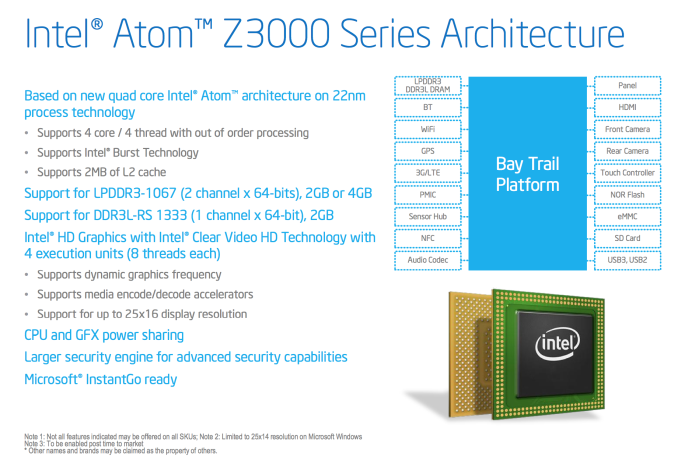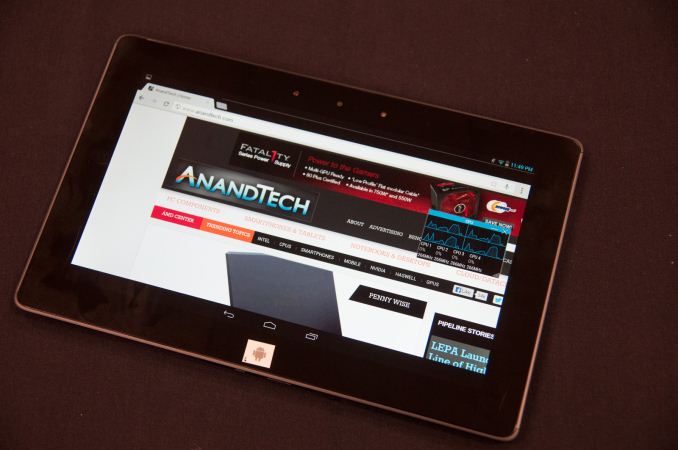The Bay Trail Preview: Intel Atom Z3770 Tested
by Anand Lal Shimpi & Brian Klug on September 11, 2013 12:00 PM ESTFinal Words
At its Silvermont disclosure, Intel promised performance better than any other ARM based core in the market today. Looking at our Android results, Intel appears to have delivered on that claim. Whether we’re talking about Cortex A15 in NVIDIA’s Shield or Qualcomm’s Krait 400, Silvermont is quicker. It seems safe to say that Intel will have the fastest CPU performance out of any Android tablet platform once Bay Trail ships later this year.
The power consumption, at least on the CPU side, also looks very good. From our SoC measurements it looks like Bay Trail’s power consumption under heavy CPU load ranges from 1W - 2.5W, putting it on par with other mobile SoCs that we’ve done power measurements on.
On the GPU side, Intel’s HD Graphics does reasonably well in its first showing in an ultra mobile SoC. Bay Trail appears to live in a weird world between the old Intel that didn’t care about graphics and the new Intel that has effectively become a GPU company. Intel’s HD graphics in Bay Trail appear to be similar in performance to the PowerVR SGX 554MP4 in the iPad 4. It’s a huge step forward compared to Clover Trail, but clearly not a leadership play, which is disappointing.
The big unknowns are things like video decode power efficiency, perf and quality of their ISP and idle power efficiency vs. Qualcomm.
Bay Trail looks like a good starting point for Intel in mobile, and the performance of Silvermont makes me excited for Merrifield in phones next year. What Intel needs to do going forward is simply continue to iterate and execute for the next few generations after Bay Trail and it will have a real chance at success in mobile.
My biggest concern is about the design wins we see based around Bay Trail. Although Intel is finally in a spot where it can be in devices on the market, none of those devices thus far have been any good. Bay Trail is attractive enough to garner more design wins for certain, the question is whether or not the quality of those wins will improve as well. In the tablet market there’s the iPad and the Nexus lines that are really the most interesting, and I don’t expect Bay Trail to be in either. Whether or not the quality of the rest goes up this generation and we find a Bay Trail in one of those devices remains to be seen.












190 Comments
View All Comments
silverblue - Wednesday, September 11, 2013 - link
I wouldn't be too sure about that. I read that GloFo had issues with 28nm at the time, and AMD had to go with TSMC, though I imagine Kaveri would be at GloFo.Nagorak - Wednesday, September 11, 2013 - link
I don't think the performance is all that surprising. Intel has been working with a major process advantage, and their CPU architecture is simply better at this point, as well.I saw some articles elsewhere on the 'net where the writer was saying they didn't think Bay Trail would use less power than Kabini, which was just stupid. If Bay Trail used as much power while on a much better process node, it would be ridiculous.
name99 - Wednesday, September 11, 2013 - link
"The question of who will win the ARM war has been answered."Uhh, no.
The multi-threaded benchmarks are completely uninteresting --- how many cores get slapped on a die is based on marketing consideration, not tech.
The interesting benchmarks are the single-threaded ones. If we believe what Apple says, the combination of the ARM-v8 ISA, higher frequency, and the usual "more transistors so smarter micro-architecture" gets Apple (and presumably the other high-end ARM designs) to rather better than this single-threaded performance, and, I would guess, at rather lower power.
romanov123 - Wednesday, September 11, 2013 - link
Can you back up this claim with any benchmark results for ARM-v8? FYI Silvermont is capable of supporting 64-bit OSes.artk2219 - Thursday, September 12, 2013 - link
The thing with Baytrail is that it has turbo core where as Kabini does not, meaning its probably spending most of its time around 2ghz or so which is 33% faster clock speed or about 25 to 28% faster on a perceptible level. It got me wondering when cinebench put them equal in IPC but everything else was saying it was faster, it makes me think cinebench super hammered the cores and everything else wasnt as punishing, thats the only way I can account for that performance boost in everything else. Im not saying that it wont be perceptibly faster, especially with lower power consumption, what I am saying is that its graphics are absolute garbage, I mean, it still loses out to Brazos... Either way for its power usage its pretty damned good, but again its a non mature 28nm process vs. a very mature 22nm one, Im definitely curious to see what kabini looks like after a refresh.xakor - Wednesday, September 11, 2013 - link
Who else is simply skipping over all synthetics benchmarks?Homeles - Wednesday, September 11, 2013 - link
Not the informed people.Krysto - Wednesday, September 11, 2013 - link
Don't forget the real speed of these is 1.33-1.5 Ghz, not whatever they're using for Turbo. But Turbo is what the benchmarks are using. You won't get that performance all the time on your device, though.virtual void - Wednesday, September 11, 2013 - link
True, but it is equally true for all current tablets/phones SoCs. See Anands review of Moto X where the CPU frequency is measured on Snapdragon 600.http://www.anandtech.com/show/7235/moto-x-review/7
Homeles - Wednesday, September 11, 2013 - link
As pointed out by virtual void, your argument (as usual) is completely invalid.